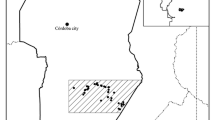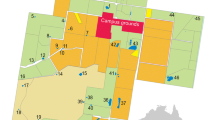Abstract
The loss of natural wetlands throughout the World has made created habitats such as gravel pits, reservoirs or rice fields potentially important for waterbird conservation. In southwest France, the increasing abundance of gravel pits has allowed several bird species to colonize the region. The avian community was studied from 1996 to 1998 in six gravel pits in the Garonne floodplain. A total of 39 species of waterbirds were recorded, with higher abundance during the winter and post-breeding periods. We analyzed habitat use to identify key environmental factors determining the temporal and spatial distribution of the avian community. The presence of submerged macrophytes was found to be the most important factor influencing the distribution of waterbirds. The presence of paths in the vicinity of the areas reduced both the total number of birds and species richness owing to human disturbance. Gravel pits have an increasingly important role in the conservation of bird biodiversity. By controlling disturbance and management of vegetation, managers can enhance this role.
Similar content being viewed by others

References
Amezaga J.M., Santamaría L. and Green A.J. 2002. Biotic wetland connectivity-supporting a new approach for wetland management policy. Acta Oecologia 23: 213-222.
Andrews J. 1990. Principles of restoration of gravel pits for wildlife. British Wildlife 2: 80-88.
Barnaud G. and Le Bloch F. 1998. Entre Terre et Eau, Agir pour les zones humides, Dossier d'information. Ministère de l'aménagement du territoire et de l'environnement, Paris, France.
Batt B.D.J., Afton A.D., Anderson M.G., Ankney C.D., Johnson D.H., Kadlec J.A. and Krapu G.L. (eds) 1992. Ecology and Management of Breeding Waterfowl. University of Minnesota Press, Minneapolis, Minnesota.
Blanco G. and Marchamalo J. 1999. Post-breeding inland movements and use of refuse dumps by audouin's gulls in Spain. Waterbirds 22: 307-309.
Blindow I., Hargeby A. and Andersson G. 2000. Long-term waterfowl fluctuations in relation to alternative states in two shallow lakes. In: Comín F.A., Herrera J.A. and Ramírez J. (eds) Limnology and Aquatic Birds. Monitoring, Modelling and Management. Proceedings of the 2nd International Symposium on Limnology and Aquatic Birds, Universidad Autónoma de Yucatán, Mérida, Mexico, pp. 165-175.
Borowiec E. 1975. Food of coot (Fulica atra L.) in different phenological periods. Polskie Archivum Hydrobiologii 22: 157-166.
Bousquet J.F. 1994. Les Anatidae en Midi-Pyrénées période 1976-1992. Le Pistrac 15-16: 22-43.
Bugnicourt J. 1988. Approche re´gionale de la migration et du stationnement des Anatidae et des foulques en Midi-Pyrénées. Le Pistrac 11: 1-22.
Burger J. and Gochfeld M. 1991. Human activity influence and diurnal and nocturnal foraging of Sanderlings (Calidris alba). The Condor 93: 259-265.
Cayford J. 1993. Wader disturbance: a theoretical overview. Wader Study Group Bulletin 68: 3-5.
Crawley M.J. 1993. Glim for Ecologists. Blackwell Science, Oxford, UK.
Crivelli A.J. 1983. The destruction of aquatic vegetation by carp. Hydrobiologia 106: 37-41.
Dehorter O. and Tamisier A. 1996. Wetlands habitat characteristics for waterfowl wintering in Camargue, southern France: implications for conservation. Revue Ecologie (Terre Vie) 51: 161-172.
Fox A.D. and Bell M.C. 1994. Breeding bird communities and environmental variable correlates of Scottish peatland wetlands. Hydrobiologia 279/280: 297-308.
Fox A.D., Jones T.A., Singleton R. and Agne A.D.Q. 1994. Food supply and the effects of recreational disturbance on the abundance and distribution of wintering Pochard on a gravel pit complex in southern Britain. Hydrobiologia 279/280: 253-261.
Glue D.E. 1970. Changes in the bird community of a Hampshire gravel pit 1963-1968. Bird Study 17: 15-27.
Guillemain M., Fritz H. and Duncan P. 2002. The importance of protected areas as nocturnal feeding grounds for dabbling ducks wintering in western France. Biological Conservation 103: 183-198.
Hafner H. 1997. Ecology of wading birds. Colonial Waterbirds 20: 115-120.
Hoyer F. 1994. Rôle des gravières et des lacs collinéaires. Le journal du chasseur 39: 6-15.
Hughes S.W.M., Bacon P. and Flegg J.J.M. 1979. The 1975 census of the great crested grebe in Britain. Bird Study 26: 213-226.
Joachim J., Bousquet J.F. and Faure C. 1997. Atlas des oiseaux nicheurs de Midi-Pyrénées, Association Régionale Ornithologique de Midi-Pyrénées, Toulouse, France, 262 pp.
Jorde D.G., Krapu G.L. and Crawford R.D. 1983. Feeding ecology of mallards wintering in Nebraska. Journal of Wildlife Management 47: 1044-1053.
Kalivodova E. and Feriancova-Masarova Z. 1998. Bird communities of the gravel pits in western Slovakia. Ekologia 17: 407-418.
Keywood K.P. and Melluish W.D. 1953. A report on the bird populations of four gravel pits in the London area, 1948-1951. London Bird Report 17: 43-72.
Klein M.L. 1993. Waterbird behavioural responses to human disturbances. Wildlife Society Bulletin 21: 31-39.
Knapton R.W. and Petrie S.A. 1999. Changes in distribution and abundance of submerged macrophytes in the inner bay at Long Poing, Lake Erie: implications for foraging waterfowl. Journal of Great Lakes Research 25: 783-798.
Küsters E. 2000. Influence of eutrophication of gravel pit lakes on bird numbers. In: Comín F.A., Herrera J.A. and Ramírez J. (eds) Limnology and Aquatic Birds, Monitoring, Modelling and Management. Proceedings of the 2nd International Symposium on Limnology and Aquatic Birds. Universidad Autónoma de Yucatán, Mérida, Mexico, pp. 221-230.
Madsen J. 1994. Impacts of disturbance on migratory waterfowl. Ibis 137: 67-74.
Mallory M.L. and Blancher P.J. 1994. Presence or absence of fish as a cue to macroinvertebrate abundance in boreal wetlands. Hydrobiologia 279/280: 345-351.
Marklund O., Blindow I. and Hargeby A. 2001. Distribution and diet migration of macroinvertebrates within dense submerged vegetation. Freshwater Biology 46: 913-924.
McNeil R., Drapeau P. and Goss-Custard J.D. 1992. The occurrence and adaptive significance of nocturnal habits in waterfowl. Biological Reviews 67: 381-419.
Pandey S. 1993. Changes in waterbird diversity due to the construction of Pong Dam Reservoir, Himachal Pradesh, India. Biological Conservation 66: 125-130.
Parejo D. and Sanchez-Guzman J.M. 1999. Effects of agricultural development on colonial ardeid populations in southwestern Spain. Waterbirds 22: 302-306.
Phillips V.E. 1992. Variation in winter wildfowl numbers on gravel pit lakes at Great Linford, Buckinghamshire, 1974-79 and 1984-91, with particular reference to the effects of fish removal. Bird Study 39: 177-185.
Prigioni C. and Galeotti P. 1989. Factors affecting the winter distribution of wildfowl in the valley of the Ticino River (northern Italy). Bollettino di Zoologia 56: 81-86.
Santoul F. 2000. L'avifaune aquatique des gravières de la plaine alluviale de la Garonne. Ph.D. Thesis, Université de Toulouse III, Toulouse, France.
Santoul F. and Tourenq J.N. 2002. Les gravières de la plaine alluviale de la Garonne comme milieu d'accueil de la Foulque macroule (Fulica atra). Revue Ecologie (Terre Vie) 57: 165-180.
SAS Institute 2000. SAS-STAST software. SAS Institute, Cary, North Carolina.
Senra A. and Ales E.E. 1992. The decline of the white stork Ciconia ciconia population of western Andalusia between 1976 and 1988: causes and proposal for conservation. Biological Conservation 61: 51-57.
Street M. 1982. The Great Linford Wildfowl Research Project-a case history. Proceedings of a Symposium on the Subject of Wildlife on Man-made Wetlands, pp. 21-37.
Sutherland W.J. 1998. The effect of local change in habitat quality on populations of migratory species. Journal of Animal Ecology 35: 418-421.
Tamisier A. 1972. Etho-écologie des sarcelles d'hiver (Anas c. crecca L.) pendant leur hivernage en Camargue. Ph.D. Thesis, Université de Montpellier, Montpellier, France.
Tucker G.M. and Heath M.F. 1994. Birds in Europe: Their Conservation Status. BirdLife International (BirdLife Conservation Series no. 3), Cambridge, UK.
Tydeman C. 1982. The general value of man-made wetlands for wildlife in Europe. Proceedings of a Symposium on the Subject of Wildlife on Man-made Wetlands, pp. 5-18.
Zorn T., Delacour G. and Robin J.P. 1995. Conditions corporelles des canards colverts (Anas platyrhynchos) hivernant en Alsace pendant l'hiver 1990/1991. Gibier Faune Sauvage 12: 79-9.
Author information
Authors and Affiliations
Corresponding author
Rights and permissions
About this article
Cite this article
Santoul, F., Figuerola, J. & Green, A.J. Importance of gravel pits for the conservation of waterbirds in the Garonne river floodplain (southwest France). Biodiversity and Conservation 13, 1231–1243 (2004). https://doi.org/10.1023/B:BIOC.0000018154.02096.4b
Issue Date:
DOI: https://doi.org/10.1023/B:BIOC.0000018154.02096.4b



